Blog
Keep up to date with the latest news from art markets across the world through our blog "the eye of the expert"
Any questions?
contact@mr-expert.com
How to recognise a Japanese print
Japanese printmaking: a history
Printmaking emerged in the 17th century in Japan. The emperor then resided in Kyoto, while present-day Tokyo was still called Edo. After a long period of political instability, the shogun Tokugawa Ieyasu set up a military government and for more than two centuries isolated the archipelago from the outside world, a situation that was a source of peace and prosperity.
This period saw the advent of a rich bourgeois class, seeking to distinguish itself by a culture of its own. It was in Edo, where a climate of artistic effervescence reigned, that this specific culture developed, which was embodied in the form of the print, first used in advertising and for entertainment. The actors of kabuki, the spoken and sung theatre that reached its peak in the mid-18th century, was one of the first themes of printmaking. Venue owners ordered posters, programmes and prints to publicise the performances.
However, it was at the end of the 18th century that Japanese printmaking reached its golden age with the arrival of Kiyonaga and then, in the 19th century, of Hokusai and Hiroshige which diversified the themes (landscapes, representations of daily life with the Hokusai Manga etc.).
Trade with Europe, which was re-established following the Meiji Restoration in 1868, paved the way for the spread of photography and printing techniques. Moreover, the golden age of printmaking was a golden age not only in Japan, but also in the West, where a Japanese trend began to develop in the 1860s with the importation of Japanese prints, a trend which was reflected in the works of Monet (La Japonaise, 1875, Boston Museum of Fine Arts), Manet or Whistler in England (La Princesse du pays de la porcelaine, 1863-4, Washington, Freer Gallery of Art).
Although Japanese printmaking, having achieved the status of national emblem, remained popular in the 20th and 21st centuries, it was nevertheless subject to a division between a specifically artistic production with works that were the subject of a real investment by the artist and a mass culture type of production, easily accessible and at very low prices.
Japanese printmaking: recognising a technique
Generally speaking, a print designates “All kinds of images made by a printing process.”, i.e. images printed on paper using the techniques of engraving, lithography or screen printing.
Engraving refers to the art of digging into metal or wood, either directly (dry point or chisel technique) or indirectly (etching technique where acid is used to dig into the metal). In wood engraving, called xylography, the process is the reverse, since the board is dug out to bring out the drawing.
Lithography, on the other hand, is the printing of a subject drawn on stone when screen printing uses a stencil between the ink and the support. The Japanese print is a woodcut, known as xylography, which generally uses a hard wood, cherry wood. Its development is mainly linked to the ukiyo-e movement (Japanese term meaning “image of floating world”) ; a Japanese artistic movement corresponding to the Edo period (1603-1868).
The ukiyo-e print proofs are produced in an orderly manner: the artist-drawer first makes a master drawing in ink (shita) and then the engraver glues this drawing against a wooden board before the board, thus engraved, is inked and printed. The proofs are then glued onto new wooden boards, and the areas of the drawing to be coloured in a particular colour are left in relief. Finally, the set of wooden plates is applied to the paper, with ready made marks (kento) allowing each plate to be adjusted in relation to the rest of the image.
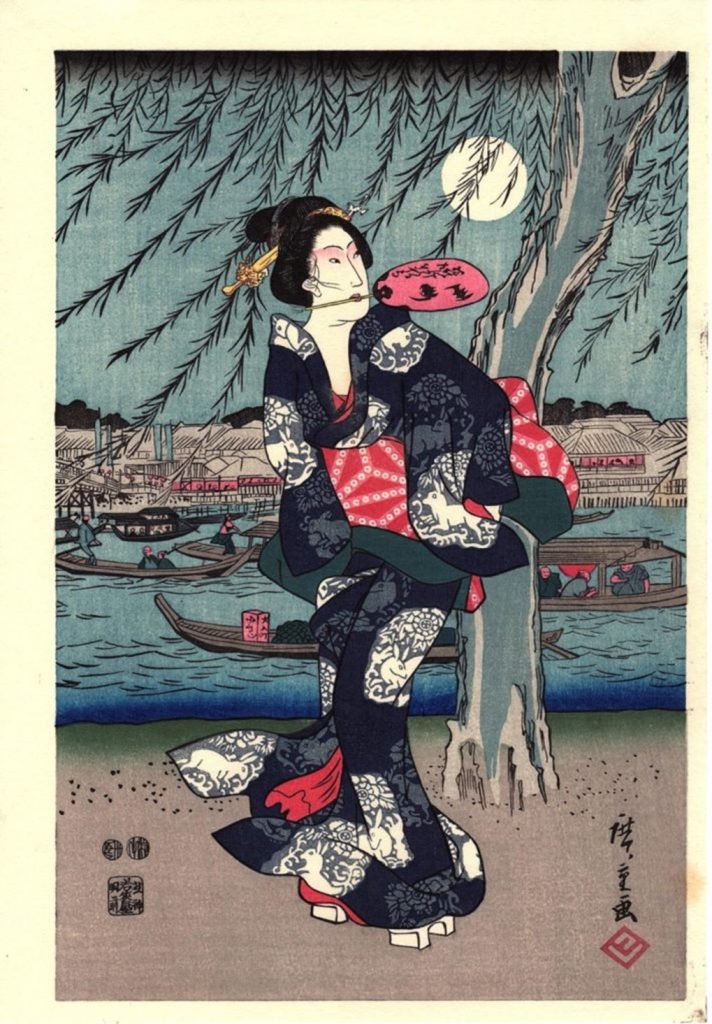
For inking, a bamboo rope stamp (baren) is used on each board. There are several applications with hand pressure on the plant paper stamp on one side of the block, one application per colour with an engraved pattern.
Japanese printmaking: recognising themes and artists
In addition to kabuki and the world of theatre, Japanese prints are based on several themes
Love and woman:
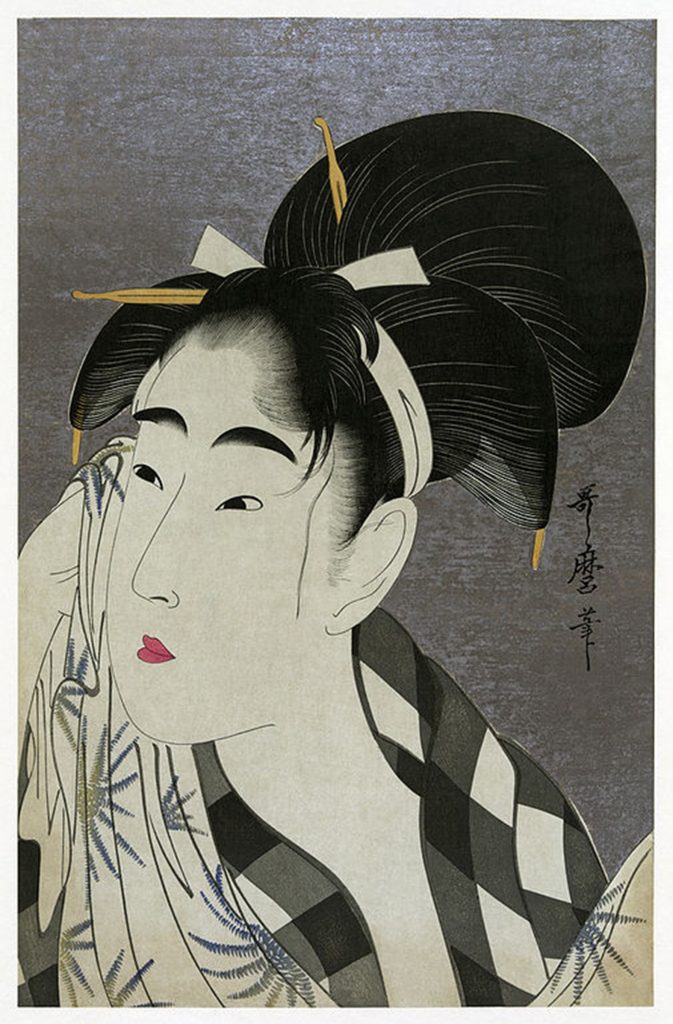
Portraits of women known as bijin-ga, are one of the main themes of Japanese prints from the 17th to the 20th century, with courtesans famous for their beauty being the most represented. The beauty of the courtesan is often associated with the richness and refinement of her garment: the kimono. Artists such as Harunobu, Sukenobu, Kiyonaga, Eishi and Utamaro owe their fame to this theme. In connection with the portraits of women, we can mention the shunga, referring to the erotic prints which reached their peak in the seventeenth and eighteenth centuries.
The weather :
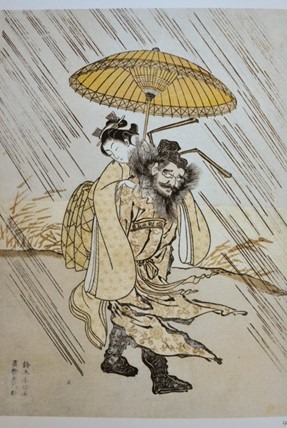
Japanese calendars in the form of prints are called e-goyomi ( images from calendrier ). The e -goyomi have a utilitarian character, but are also rich in witty playfulness since the artist conceals, in the details of the print (kimono, belt), the long months of the year.
The fantastic :
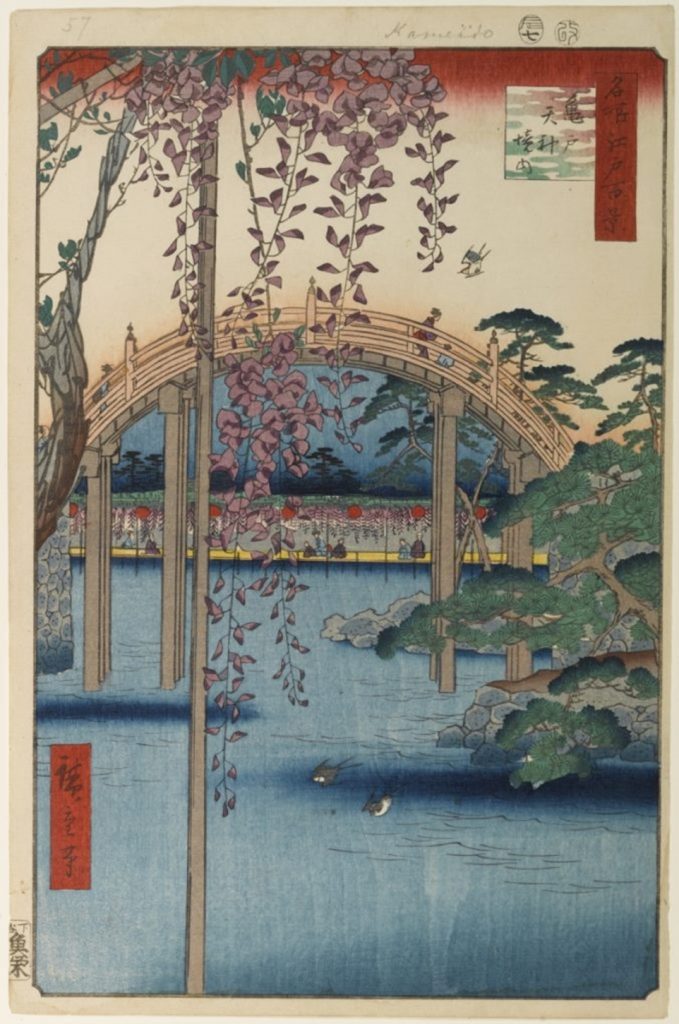
This theme is mainly present in Utamaro (One Hundred Stories of Demons and Spirits) or Hokusai in several prints (Lavis in Indian ink, a study by Hokusai, for a ghost of a drowned woman, around 1840) and in his sketchbooks, the Hokusai Manga. He is also to be found in Hiroshige (The Hundred Views of Edo).
Observation of nature :
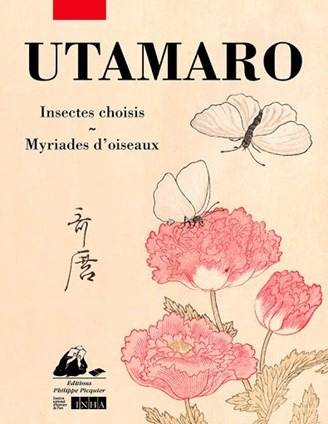
The representation of nature in the print is first of all similar to the work of a naturalist, as evidenced by three works from Utamaro: The Selected Insects (1788), the Book of Birds (1791), and Memories of Low Tide (1790-1791). It was in the 19th century that landscape took on an increasing role in Japanese prints, in line with developments in Japan.
The beginning of tourism, with the development of paths from Edo to the more rural regions, offered artists the freedom to travel to feed their work. Hokusai and Hiroshige became the main representatives of the Japanese landscape translated into prints with the creation of series describing the most beautiful Japanese sites, the most famous of which are the Thirty-six views of Mount Fuji (Hokusai) or the Hundred Views of Hiroshige.
You may also like
How to identify an Antique Chinese Porcelain Vases?
Ancient Indian painting & Contemporary Indian painting